#traditional catholic gothic
Text

Roughly translated from the Latin; " All things must pass."
#traditional catholicism#traditional catholic images#traditional catholic modern art#traditional catholic gothic#sic transit gloria mundi#all things must pass
996 notes
·
View notes
Text

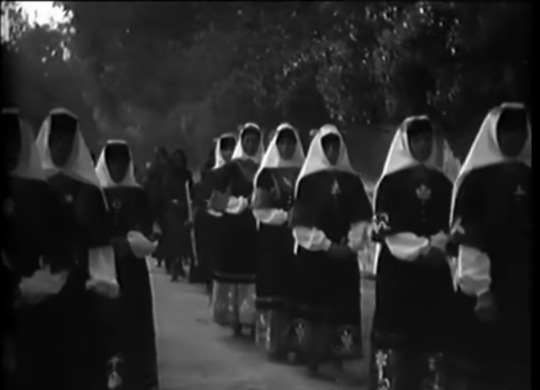
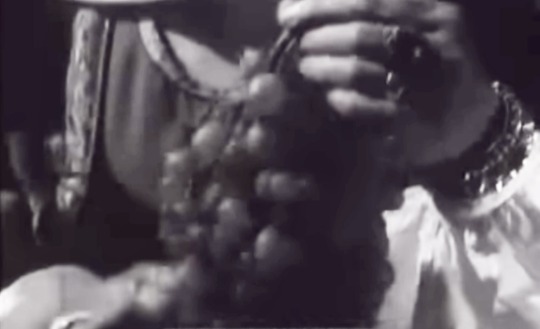



traditional procession, northern Italy, circa 1931
#antiquities#coquette#dark academia#daughters of cain#ethel cain#forest core#italy#girlhood#morute#nature core#nicole dollanganger#vintage#old stuff#chaotic academia#traditional femininity#religion#catholic#catholic core#somewhere in northern italy#southern gothic#padanian gothic#southern gothic aesthetic#women#womanhood#dark femininity#dark feminine aesthetic#ultraviolence#female hysteria#hell is a teenage girl#dark coquette
112 notes
·
View notes
Text
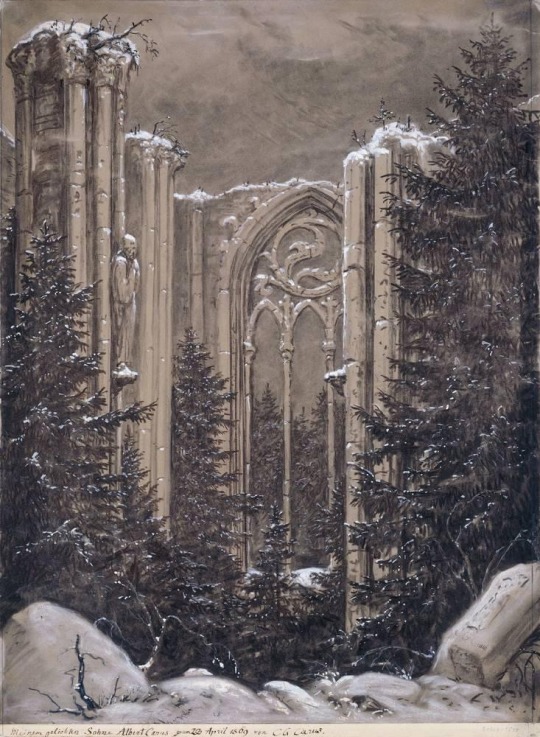
Ruin of a gothic church in the forest, by Carl Gustav Carus
#carl gustav carus#goth architecture#goth#gothcore#dark forest#goth art#goth aesthetic#art#painting#classic art#illustration#traditional illustration#catholic#xix#xix century#catholic church#catholiscism#gothic church
58 notes
·
View notes
Text

This is Marzia Zinno!
She's a 14 year old girl that was born and raised in Italy. She's goth, and she converted to Catholicism by her own will when she was 13. Her mom and dad are Carlos and Lisa, and her stepmother and half sister are Beatrice and Cierra. She also has a twin brother named Anthony.
She is apart of the Sepsis story :D
#my story#oc#original characters#sepsis#gothic#goth aesthetic#goth girl#goth#goth characters#original character#original art#traditional art#traditional illustration#traditional sketch#traditional drawing#oc art#oc artist#my ocs#my characters#character info#character design#character description#catholicism#catholic#pencil art#sketchbook#sketch#drawing#my art
6 notes
·
View notes
Text
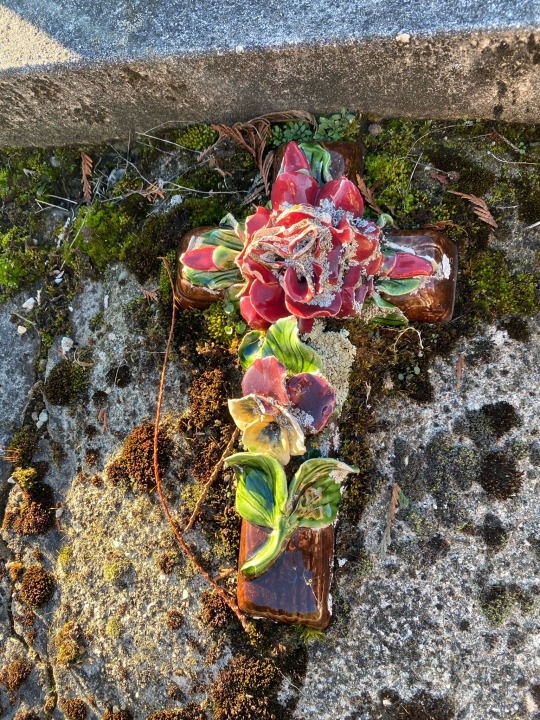
#cross my heart#cross#crucifix#st therese of lisieux#graveyard aesthetic#gravestone#graveyard#grave#cemeteries#cemetery#floral aesthetic#floral gothic#traditional catholic#warm aesthetic#original photography#original photography on tumblr#original photographers#my photography#found objects#historical aesthetic#victorian style#victorian aesthetic#vintage aesthetic#dark academia aesthetic#academia aesthetic#vintage academia#dark academia
26 notes
·
View notes
Text

Forgive me Father for I have sinned
OR
"What are we made of but Hunger and Rage" - Anne Carson
Inspired by Midnight Mass. I love the intersection of Horror and Religion. As someone from a very catholic country there is so much potential for the monstrous in the holy and the holy in the monstrous.
Redbubble and Inprnt link in my blog description.
#vampire#vampire lady#saint#catholicism#catholic#christianity#religion#religious horror#midnight mass#holy#halo#art#watercolor#traditional artwork#horror art#macabre art#gothic art#fine art#traditional art#artist#watercolour#dracula#hlblng
28 notes
·
View notes
Text

Time for Mass
#catholic#catholicism#christianity#christian#jesus#church#catholic church#traditionalism#trad#tradlife#traditional#aesthetic#art#artistic#beauty#stained glass#southern goth aesthetic#midwest gothic
5 notes
·
View notes
Text
Kodeń
Today the people of Poland celebrate Palm Sunday, which means the anticipation for the Easter is growing stronger within Poles, me included. I'm not religious, but being raised in Catholic tradition, I truly enjoy some of its elements, such as feasting on the traditional dishes with your family (and, of course, the preparation of those dishes beforehand^^), but also the historical sights related to Roman-Catholic Christianity.
It has always amazed me how diverse and rich is Polish architecture, especially the castles and churches built in the past. Yesterday, my loved one, knowing so well how much I would enjoy it, took me on a spontaneous trip to one of those places which's historical landmarks manage to combine both<3
Using both the opportunity and my pre-Easter spring mood I shall share some photos of the beautiful Kodeń village with you.
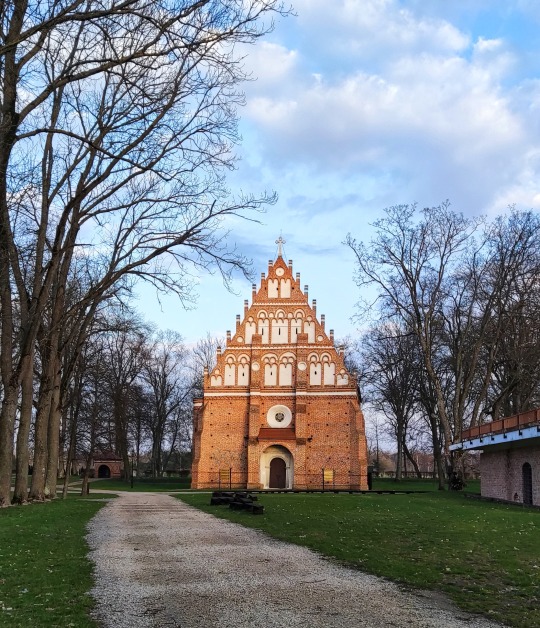
Kodeń [ˈkɔdɛɲ] is a village in eastern Poland on the Bug River, which forms the border between Poland and Belarus. Administratively, it belongs to Biała Podlaska County in Lublin Voivodeship.
[ the description taken from the Wikipedia ]
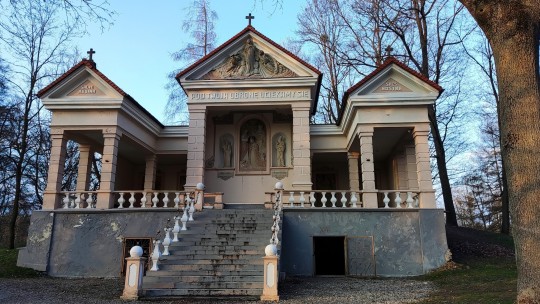

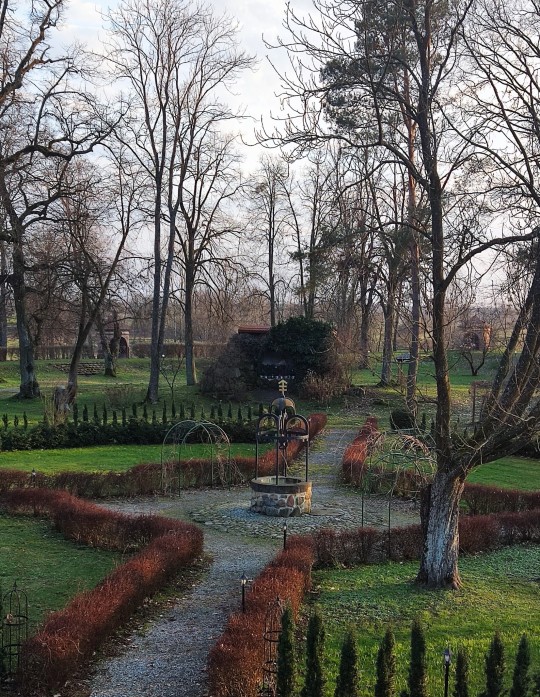
Kalwaria Kodeńska | The Kodeń Calvary
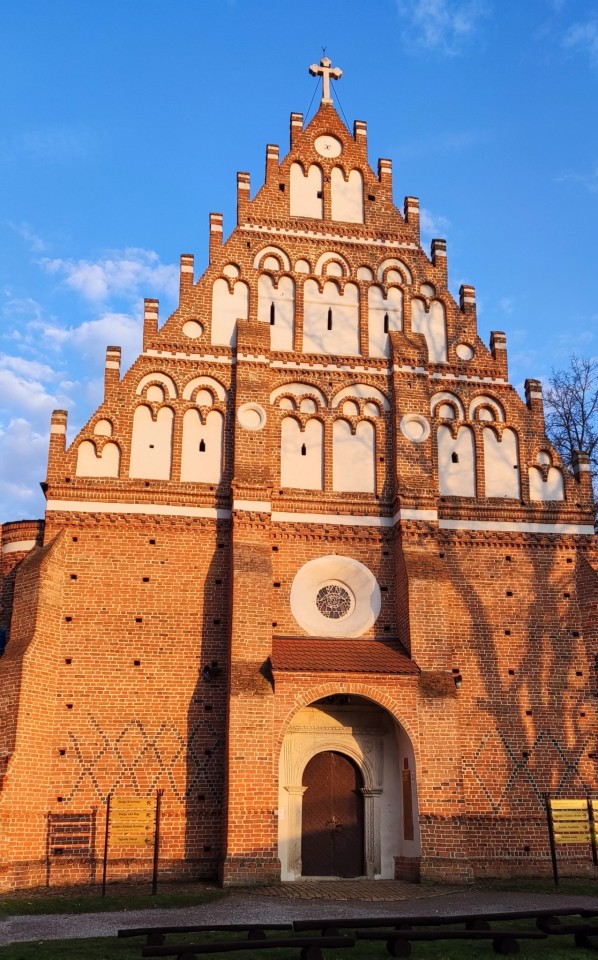
Kościół Świętego Ducha | Church of the Holy Ghost
The Gothic castle church, currently a Roman Catholic filial church of St. Anna's parish in Kodeń.
The temple, along with the ruins of the Sapieha castle, the former armory, and the stations of the Via Dolorosa processional route, compose the area of the Kodeń Calvary.
The church was founded at the same time as the Kodeń castle by the Voivode of Nowogródek, Paweł Sapieha, around 1540. It served as the Sapieha family court chapel until the 19th century.

Bazylika św. Anny w Kodniu | St-Anne's Basilica
The church of the Roman Catholic parish of St. Anna in Kodeń.
The church was built between 1629 and 1635 in the late Renaissance style on the site of an earlier wooden church from 1599. The construction was led by the Lublin mason J. Cangerle. In 1657, the church was plundered by the Swedes who removed the lead roof and stole the bells. In 1680, fire destroyed the church and the town, but by 1686, after the completion of its reconstruction and alteration (western tower), the church was consecrated again.
The Baroque façade dates back to 1709.

The altar of the Basilica - Matka Boża Kodeńska | Mother of God of Kodeń
[ the descriptions of the churches were taken from the Polish Wikipedia and were translated into English by me ]
#poland#landscape#polish landscape#art#polish architecture#architecture#church#history#catholicism#christianity#easter#palm sunday#kodeń#polska#polish#polblr#spring#travel
20 notes
·
View notes
Text
Roundtable: The Hunchback of Notre Dame (1996) dir. Gary Trousdale, Kirk Wise

Description on Disney+:
Quasi leaves his tower on Notre Dame to help a kind and beautiful gypsy.
The Hunchback of Notre Dame is a true hidden gem of Disney's animated filmography, and a movie I've found so fascinating, shocking, and genuinely terrifying since I was a kid. The film was produced and released by Disney in a period retroactively referred to as the "Disney Renaissance," in which the company released several cutting edge animated musicals within a few years of one another, almost all of which were based on literature, history, or cultural mythology as opposed to classic fairy tales. While many of these films were relatively progressive and boundary pushing, Hunchback remains one of Disney’s most daring ventures with its criticism of religious hypocrisy and dark themes of xenophobia, lust, and morality.

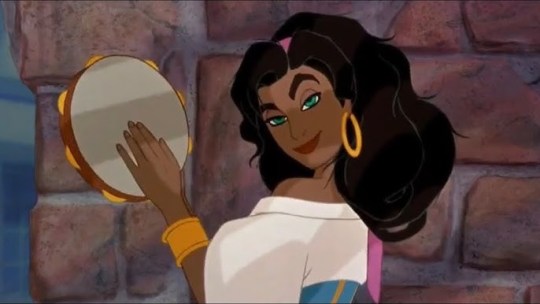


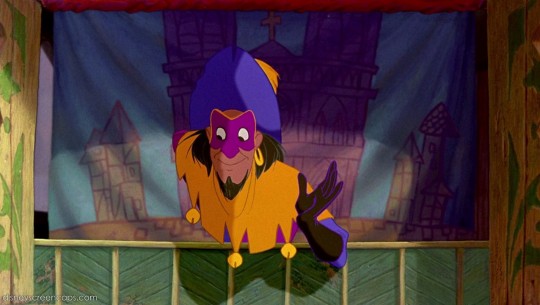

Based on Victor Hugo’s 1831 Gothic novel of the same name, The Hunchback of Notre Dame occurs in Paris in the late 15th Century and highlights tensions between Catholic officials and Romani migrants. The film tells the story of Quasimodo, a deformed man who rings the bells of the Notre Dame Cathedral and must remain in the bell tower under the orders of Judge Claude Frollo, a corrupt minister who took a baby Quasimodo from Romani people attempting to flee twenty years prior. Frollo has made it his lifelong mission as the “Minister of Justice” to rid Paris of its Romani population, and hires Captain Phoebus to find the Romani’s safe haven hidden in the city. Frollo’s efforts are complicated by Esmerelda, a defiant gypsy woman whom he lusts after. Esmerelda befriends Quasimodo and the two help one another escape their situations of imprisonment. Meanwhile, Frollo begins to burn down the city of Paris until he finds Esmerelda, adamant that if he can’t “have” her, he’d like to kill her.
The film is partially narrated by Clopin, a Romani jester-type figure who also plays a role within the story in the second-act. Other secondary characters are Quasimodi’s three talking gargoyle friends (one of whom is voiced by Jason Alexander/George Costanza).
Scoring and Narrative Context

Hunchback’s music is very crucial to distinguishing and defining the cultural identities of its characters, and its distinct musical styles are often associated with the space and physical location in which a musical number is performed. Given that the narrative centers on cultural differences between religious and ethnic groups, the film’s music takes influence from both Romani folk music and Catholic hymns. The uses of these two musical styles are differentiated by who is singing each number and where the number occurs.
Romani folk music, for instance, makes up the introductory song “The Bells of Notre Dame” and the festival number “Topsy Turvy” which are both performed by Romani people and peasants on the streets of Paris. These numbers are fast paced, colorful, and lively, with percussion instruments and discordant chants by the crowds. Lyric and dialogue are indistinguishable from one another as these songs blend seamlessly into the diegetic space of the film and move the narrative forward.
The film uses Catholic music to underscore its scenes in the Cathedral, with deep bells and choral singing creating a contrast to the lively folk music signifying the world outside. It’s with this haunting music that the film’s critique of religious hypocrisy, characterized through Frollo, takes form. The sound of bells often linger as characters wander throughout the cathedral, a precarious space with guards at every turn despite being promoted as a “Sanctuary” for Romani people.
Quasimodo’s songs take elements from both musical styles while also embodying Disney’s more traditional “hero” songs, as he is confined to the cathedral yet yearns for the world of folk music and “freedom” on the streets of Paris.
Familiar Musical Framing

In her essay on the Western musical lens of Disney’s Moana entitled “Time to Face the Music,” Armstrong writes “This musical containment of unfamiliar sounds by familiar ones limits the audience’s access to the unfamiliar, controlling the representation of the otherness of Polynesian music” (113). This idea is quite relevant in reading Hunchback’s selective uses of Romani music and culture, specifically in regards to the character of Esmerelda (who is voiced by white actress Demi Moore).
As Quasimodo and Esmerelda become friends, Quasi remarks that Esmerelda is “not like other gypsies.” Though Esmerelda immediately refutes this claim and encourages Quasi to unlearn the discriminatory ideas which Frollo has taught him, I find that the film itself upholds Quasi’s sentiment through its formal elements. It is particularly through music that Esmerelda becomes more associated with Western culture than with the Romani culture to which she actually identifies. Her solo “I Want” song, “God Help the Outcasts,” is sung in the Cathedral and fuses elements of an archetypical Disney princess song with a Catholic prayer/hymn. It is through this Western visual and sonic environment that we are expected to most sympathize with Esmerelda.
Additionally, this number emphasizes the extent to which Esmerelda is chiefly an object of the male gaze. This is already apparent at a surface level, with her sexualized outfit, constant references to her appearance (see Disney+ description above), and the way her sexual allure brings about Frollo’s most villainous inclinations. Even further, there are only a few scenes in the whole film where Esmerelda is not being looked at by one of the three principal male characters.
For instance:
(play last 30 seconds)
youtube
Even in what seems to be a private moment of prayer, Esmerelda is being watched by Quasimodo and the gaze of the camera for nearly the whole song. Her positioning within the way of light from the stained glass window at the end of the song makes her seem angelic, contrasting Frollo’s depiction of her as a seductive demon (coming up below). I argue that this over-positive representation of her is still dehumanizing, as she is represented as a conceptual figure of goodness rather than a whole person. The angelic way that Quasi views her also contributes to the film’s penultimate act of white saviorism in its climax:

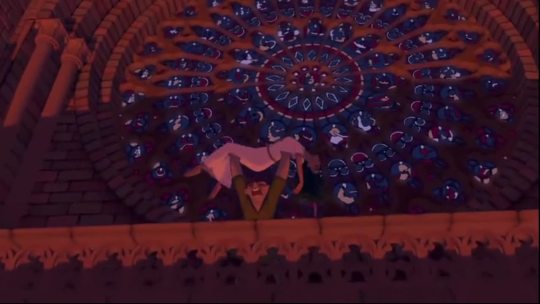
Character Performance

As I began to touch on before, the musical direction of the film intrinsically links Frollo with the church, and even further associates his “religious” motives of justice and morality with evil and monstrosity. Frollo is displayed as corrupt and irredeemable from the first minutes of the film, with the chords of his song “Hellfire” played around his acts of evil several scenes before he performs the song. The film thus toys with the idea of “authenticity” by attaching Catholic-inspired music to one of Disney’s most evil characters to date. I don’t exactly think that the film is making a statement against Catholicism as a religion, but is rather pointing out the sense of evil that lies within those who believe themselves to be the most morally sound.
This brief moment from “The Bells of Notre Dame” and the iconic song “Hellfire” should speak for themselves:
(0:25-0:55)
youtube
(0:20-1:45)
youtube
Still, in making the unmistakable point that Frollo’s objectification of Esmerelda is very bad, all other acts of objectification towards her (and Romani people in the film more broadly) seem “good” in sheer comparison. The heightened attention to her beauty and sexuality also not only sexualizes Romani women, but echoes wider cultural notions of who is deemed “worthy” of saving.

17 notes
·
View notes
Text

T
he herm of Saint Ladislaus
SACRAL RELICS
The herm means head-reliquary. In this case, it holds Saint Ladislaus King’s sculpture and we definitely can say that it is the most valuable piece of Hungarian metalsmithing.
The head of the herm is made of gilded, embossed silver. The sculpted reliquary was put inside, in a silver case. The work on the shoulder and chest was crafted with the wire enamel technique. This technique is from 14th century of Byzantium which from there spread to other parts of Europe thanks to Venice. And what is the wire enamel?
Artisans put plates on the subject they are decorating and they solder twisted silver wire to make subdivisions. Then they fill the subdivisions with enamel. While the enamel burns out, it shrinks and the twisted silver wire bulks from the surface.
Experts have argued a lot about the makers of the herm. Some think it was made by Márton Kolozsvári and György Kolozsvári and portrait of III. Béla is seen in the herm by that group. Saint Ladislaus was blessed during III. Béla’s reign. The others think that the head part was made around the 12th-13thcentury at Dénes master’s workshop.
We know as following the old traditions his grave was opened and his head and arms were put in separated shrines so they could make them religious relics before he became blessed in 1192. The next time it is mentioned in records was in 1273 that his sculpture was kept in the shrine in the Cathedral of Nagyvárad where Saint Ladislaus was buried. They used it at the vows. According to one of King Zsigmond’s certificates the herm was destroyed in the great fire of 1406 but the relic survived it. This is when the new herm was made with the technique mentioned earlier between 1406 and 1443. We know this because they held the herm under the tower of the cathedral in Nagyvárad. This tower collapsed but the herm did not get damaged at all.
According to legend Saint Ladislaus’ grave was robbed in 1565 but Bishop Demeter Náprági was able to get the shrine back. When he needed to leave Várad because of the persecution of the catholic people, he took the shrine with him to Gyulafehérvár, Bratislava and in 1607 to Győr. Not too long after Bishop Walter Lynch arrived in Győr and brought the Weeping Madonna painting that wept blood.
Bishop Demeter restored it in Prague. This is when the roller neck and the neck ring got on it that we can see today and this is when its gothic crown was changed. The crown is decorated with Czech grenades and glass and uncolored quartz insets.
Knight King’s personality cult was not foreign for the citizens of Győr before the arrival of Demeter Náprági. Győr town looks at the Saint King as its personal patron since that moment that Győr gave home to this national relic. The story of the earthquake in 1763 belongs to it also. Thanks to that Győr has a tradition since then and the town got a new legend that you can read about here.
They opened the herm for 4 days in 2011. The scientists (doctors, anthropologists and boffins) started a research project to get answers for the following questions during this 4 days: is there a sculpt relic in the herm? Is it a full sculpt or just pieces of it? And does this relic really belong to the Knight King?
The lower jaw and most of his teeth were missing and also little pieces of his sculpture, likely because others took small parts of this relic before as well. János Simon bishop of Győr who became diocesan bishop of Esztergom in 1867 took a tooth of Saint Ladislaus that is kept in a shrine in the Basilica of Esztergom. The shrine was made in Vienna. A little piece of the sculpt and one of the remaining 3 teeth were taken to do some research. The first fact that was figured out that Saint Ladislaus was totally healthy when he died.
The anthropology examination made sure that the herm holds the sculpture of Saint Ladislaus. We can see the colored part on the top of the sculpt and that matches the openings of the shrine that is a strong proof that the original sculpt was kept in it for centuries. Also it shows that it is Saint Ladislaus’ sculpt that it has rugged features of a man who was between 45-55 years old that is shown on the face reconstruction. This face reconstruction is very similar to the one that was made by the sculpt of the III. Béla.
See insights and ads
Boost post
All reactions:
6You, Hungarian Tourism Guide and 4 others
7 notes
·
View notes
Text

A Traditional Catholic gothic image of a statue of Our Sorrowful Mother.
#traditional catholicism#traditional catholic images#traditional catholic gothic#traditional catholic marian devotion#traditional catholic marian statues#our sorrowful mother#the blessed virgin mary
17 notes
·
View notes
Photo
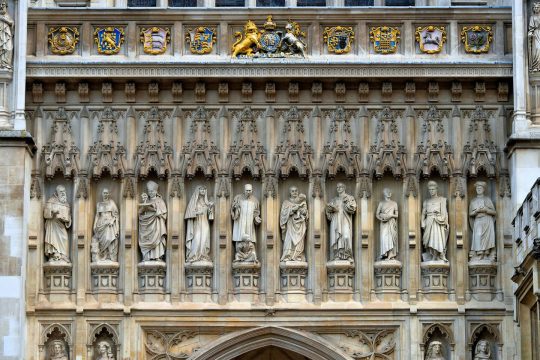

Quid est martyrium? Mortem pati pro Christo. Quid est Christianum? Christum sequi*
- St. Augustine
What is martyrdom? To suffer death for Christ. What is a Christian? To follow Christ.*
After the restoration of the western towers of the Abbey had been completed in 1995, it was decided to fill the 10 gothic niches above the west doorway with statues. The lower part of the towers date from the 15th century and the tops of the towers were completed in 1745. The niches never had statues, although this was obviously the plan of decoration.
It was decided to use the ten niches not just to commemorate saints or worthy figures from the past. So instead of traditional figures of kings or saints, the abbey decided that martyrs of the 20th century should be remembered. The West entrance was to proclaim a message of which too few people are aware: the 20th century was a century of Christian martyrdom. Although the statues are of individual martyrs they are intended to represent all those others who have died (and continue to die) in similar circumstances of oppression and persecution. Their statues were drawn from every continent and many Christian denominations.
Four sculptors completed the statues, carved from French Richemont limestone. The Archbishop of Canterbury, George Carey, unveiled the statues in July 1998 at a service attended by HM Queen Elizabeth II.

The ten Christian modern martyrs are (from left to right):
Maximilian Kolbe: a Catholic priest who helped Jews in Poland and who died in Auschwitz in 1941 after offering to take the place of a condemned man.
Manche Masemola: a 16-year-old girl from South Africa who was killed by her parents in 1928 when she converted to Christianity.
Janani Luwum: the Archbishop of Uganda who was murdered on the orders of Idi Amin in 1977.
Grand Duchess Elizabeth Feodorovna: a member of the Russian Imperial family (by marriage) who founded a convent but was murdered by the Bolsheviks during the Russian Revolution.
Martin Luther King: the American civil rights campaigner who was murdered in 1969.
Oscar Romero: the Archbishop of San Salvador, murdered by a death squad in 1980.
Dietrich Bonhoeffer: a Lutheran theologian who was implicated in the bomb plot against Adolf Hitler and executed in 1945.
Esther John: a Pakistani nurse and Christian evangelist who was murdered by a Muslim relative in 1960.
Lucian Tapledi: an Anglican in New Guinea who was killed by invading Japanese troops in 1942.
Wang Zhiming: a Christian pastor in China who was executed in 1973 during the Cultural Revolution.
In June 1953, during Her Late Majesty Queen Elizabeth II’s coronation, she entered through the west door of London’s Westminster Abbey. During her arrival, she was received by massed choirs singing “I was glad when they said unto me, we will go into the house of the Lord” (Psalm 122, 1-3,6, 7.)
On 6 May, King Charles III and Queen Consort Camilla will be crowned at Westminster Abbey. For many, this will be the first coronation they have ever seen. The ceremony will follow a pattern laid out in the Liber Regalis, kept at Westminster Abbey and which has informed the pattern of coronations since the 14th century. The service which will see the Coronation of King Charles and Queen Camilla will include the same elements as the historic coronations which have gone before and everything starts with their entry to the Abbey. This means King Charles III will enter the Abbey through the West door and under the statues of these 10 Christian modern martyrs.

For King Charles III it will have a particular personal resonance as he will walk under the soulful gaze of his great-great aunt through his father’s side (the late Prince Phillip, Duke of Edinburgh), Grand Duchess Elizabeth Feodorovna.
Elizabeth of Hesse-Darmstadt was born on 1 November 1864. Her mother died when she was a child, and she came to England to live with her grandmother, Queen Victoria. Her childhood was Lutheran and her adolescence was Anglican. Elizabeth married Grand Duke Sergei Alexandrovich, the fifth son of Tsar Alexander II of Russia in 1884, and joined the Orthodox Church in 1891.
When her husband was assassinated in 1905, she gave away all her jewellery, sold her most luxurious possessions, and opened the Martha and Mary home in Moscow. Elizabeth and 17 of her companions formally became nuns in 1909. They soon opened a hospital and began other philanthropic works.
The Tsarist state collapsed in March 1917, and the Bolsheviks seized power in October 1917. Elizabeth was arrested with two sisters from her convent on 7 May 1918, and transported across country to Perm, then to Ekatarinburg, and finally to Alapaevsk. On 17 July, the Tsar and his family were shot dead. During the following night, Elizabeth, Sister Varvara, and members of the royal family were murdered in a mineshaft. Elizabeth was recognised as a saint by the Russian Orthodox Church Abroad in 1984 and by the Moscow Patriarchate in 1992.

Had there been more than ten niches available, there would have been other candidates available for inclusion in Westminster Abbey. As it stands, this memorial makes a powerful statement about the fact that people are still dying for their Christian beliefs in the present age. Although most cathedrals only seem to commemorate people who are long-dead and long-forgotten, Westminster Abbey bucked the trend in a dramatic and highly poignant way.
#st augustine#augustine#quote#westminster abbey#martyrs#martyrdom#christianity#west door#modern martyrs#statues#coronation#king charles III#monarchy#cathedral#church#faith#heritage#custom#tradition#christian#society#britain#england
51 notes
·
View notes
Note
HC? If Louis or Lestat were painters or did art of some kind what would they paint or draw? Or if that doesn't jive, what would be their favorite kind of art/art style?
Ooh good question!! Sorry it took me so long to get to it!
I think Louis would want to do some Francis Bacon style grimdark self portraits but would have too much dignity for that and take a more "refined", naturalistic but moody route, maybe Carvaggio or Rembrandt-esque with some very dark religious themes. He's trying to resurrect Tradition but is still soooo Catholic /neg.
As far as art styles he likes to look at, definitely an Old World masterpieces guy, really anything evocative and Catholic like the Italian Baroque painters. He'd cry in front of a particularly poignant altarpiece for sure or if the light hit a Cimabue just right. Maybe Giotto would speak to him, some early Renaissance naturalism combined with the more mystical, fantastical Gothic style. Big stained glass enjoyer too I think.
If Lestat was an artist, I can't imagine him doing anything but performance art, I think he'd act of course, but maybe also do more abstract, interpretive theater. I bet he would come up with some very cool inter-medium shows. Maybe Armand is involved with him doing fucked up short films.
Lestat doesn't seem like a paintings guy to me as much as sculpture or collage or things like that. I think he appreciates the beauty in painting, but is more drawn to super dynamic, experimental works in terms of visual art, things that exemplify modern life like Warhol and the pop artists or Jeff Koons. This isn't my area so I don't have many specifics, but hopefully you know what I'm talking about. He probably also likes anything that Louis hates just be annoying.
8 notes
·
View notes
Text
Getting Lost in Italy
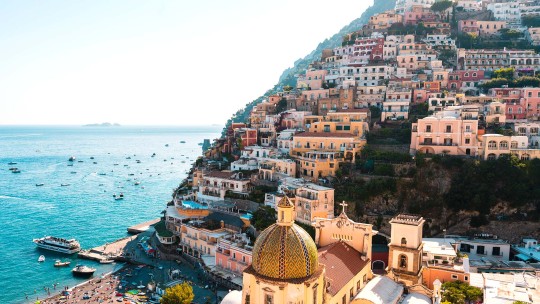
Italian Culture
Italian culture is composed of a beautiful mix of art, architecture, history, music, and food, making it a must-see destination. Italy is home to a wide variety of historical landmarks and sites, from the Leaning Tower of Pisa to the Colosseum in Piazza dei Miracoli, all sure to make your visit one to remember! Much of the culture in Italy is strongly influenced by religion, the Roman Catholic Church and Roman Mythology being the most prominent in historical and cultural aspects such as their architecture and art. In terms of customs, family orientation and a strong sense of community is what Italians are known for, and when visiting this country, expect gracious hospitality from the residents.
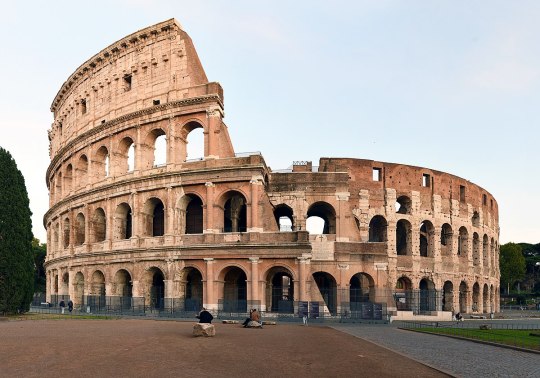
Food
Italy is famous for its high-quality cuisine that has become popular all over the world. This ranges from different variations of pizzas, pastas, risotto, cured meats, seafoods, cheeses, and my personal favorite, gelato! All of the ingredients used in Italian dishes are fresh and flavorful, and there is simply nothing like it! Whether you are fine dining or just roaming the cobblestone streets looking for a quick bite, Italy has some of the best cuisine if you’re a foodie looking to try a little bit of everything. In comparison to the United States, tipping is not as common in Italy, however it is important to show gratuity to these friendly residents.

Attractions and Activities
Rome is the capital of Italy and home to numerous historical events, and it is because of this that there is so much to see and experience. In Rome, ancient ruins of the Colosseum and the Pantheon monument are unforgettable spots. I would recommend visiting the Vatican City, home of the Roman Catholic Church, which holds the gorgeous Sistine Chapel and St. Peter’s Basilica, featuring some of the world’s most famous religious and renaissance style art/architecture. Florence is another go-to destination for gorgeous architecture and museums. Be sure to check out the Academia Gallery to marvel at The Statue of David! While you're in Florence, don't forget (though it's hard to miss) the breathtaking Duomo Catholic Church, which features stunning gothic architecture. When visiting these holy places, make sure to dress modestly and be respectful of the traditions and customs. If you venture to Venice, the Grand Canal is one of the main waterways that takes you through the beautiful Italian architecture. A gondola ride through the gorgeous bridges is something you have to experience for yourself! And finally, if you’re feeling adventurous, take a trip to southern Italy to the Amalfi Coast to see picturesque views and colorful towns that line the breathtaking cliffs.

Transportation
Italy has a great array of transportation methods that make getting to one city to another quick and easy for travelers. Depending on where you are, the most popular methods of transportation include trains, buses, and taxis. Italy has very narrow streets, so the best way to really get around the cities is by walking, but I would recommend the trains if you are traveling long distances, as they are very straight forward and inexpensive. If you happen to find yourself in Venice, and are wanting a more scenic method of travel, the city offers a considerably large network of transportation through canals using gondolas, ferries, and water taxis. These rides are extremely fun and I would highly recommend if you get the chance!
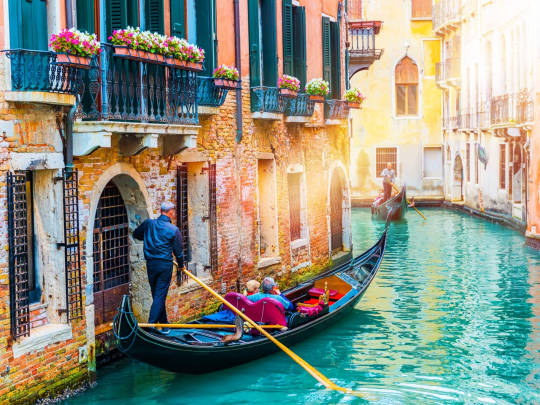
#italy#landmark#vatican#rome#colosseum#amalfi coast#venice#italia#pope francis#grand canal#travel#international#study abroad#wanderlust#adventure#pizza#pasta#italian cuisine#italian culture#monument#sistine chapel#st peter's basilica#places to explore#solo travel#bucketlist#vacation#gelato#italytravel#cuisine
37 notes
·
View notes
Note
Character analysis for Tolys and the theme of gothic romanticism, perhaps.
So I will continue this in a second part probably to discuss themes like Psychological Torment, Sin, Struggles of human nature, the supernatural, etc.
First theme: Nature
So Romanticism came in a time where nature was seen as idealic compared to the rapid urbanization and the modernity of the industrial revolution beginning the late 18th century. Now Gothic Romanticism uses nature to emphasize the grotesque, the dark, the irritational and horrific aspects, that we find ourselves drawn to even if we feel we shouldn't be.
Nature is beautiful in it's creation and destruction. We can't transcribe human morals to nature. And man may see himself as above all living creatures but he too is just one of many of the world's animals and but finds himself in conflict with his reason and his instinct and drive.
Tolys sees himself apart of nature. Having never truly abandoned his pagan roots, nature has remained his idea of divinity. You seek to understand the divine through understanding nature. But that futile task exemplifies human ego that one thinks they could possibly comprehend the nature in its vastness and the divine in it's unknowing.
Rather than fearing nature and natural instincts, Tolys embraces it. Nature is beautiful but terrifying and sometimes there is beauty in that those terrifying forces or destruction.
Acceptance of the unknown
Probably the ultimate unknown is death. The forces of life and death fuel nature and everything that stems from there. Tolys is in an odd position when it comes to death. He doesn't age and could live forever hypothetically, but he knows he is alive purely by chance and has survived purely by chance. He has seen countries rise and fall and nations wiped off the face of the earth and forgotten, after all Tolys was one of many baltic tribes in his youth yet he's one of the few who remains to this day.
(disclaimer I'm not an expert on early Baltic history and am still figuring out my headcanons especially with Prussia.)
I think he and Gilbert in particular have an acceptance of death that I think probably makes others uneasy.
To get the vibes across I always think of the traditions of día de muertos, a celebration of death, and the mix of catholic and indigenous traditions that have survived dispite oppression and destruction and I feel that just fits Tolys surprisingly well.
And it really shows that even when something disappears traces remain. I mean just look at how cultures and groups evolve.
Wolves
Sorry for this over emphasis among nature when that is usually just one of many aspects. (I'm an environmental studies major so it's my fault)
Ooh this goes so well with the the idea of the fascination of the evil, the dark, the outcasts of society etc. Because okay those reading you are so far removed from wolves that you probably just see them as large dogs. Okay, they aren't, and people really didn't like wolves because say one night a pack of wolves kills your entire flock of sheep you're probably going to think those wolves are dicks when your whole livelihood was destroyed. This is why some species of wolf have gone extinct through extermination campaigns. But are the wolves the evil ones? Not necessarily the wolf has three objectives in life
Be wolf
Eat
Make more wolves
You were going to do the same thing to those sheep afterall later before you also have three main objectives in life.
1. Be person
2. Eat
3. Make more peoples
Wolf probably had a family to feed and they saw an all you can eat lamb buffet. You have a family and you would probably go ooh my family needs food to survive, lamb buffet in the same situation.
Are you really much different than the wolf? Are you really much different than the thing you fear and hate?
Tolys gets wolves. Their goals are be wolf, eat make more wolves and and survive, Tolys' are be Tolys, eat, fuck, and survive.
Idk I think it just fits especially in the context of the crusades where his existence is seen as dangerous because he is the unknown, and the unknown is feared.
Tragedy
This is one of those things that really draws me to his character. And it's the fact that he has achieved greatness and he has fallen and claws himself back up knowing full well what he has in his hands now is no guarantee for the future. He is haunted by the horrors of the past because he knows that it's inevitable in the future he will face them again. After all the higher you reach the closer you are to the sword of Damocles hanging above you.
I hope this makes even the tiniest bit of sense and I hope this or the second half is what you were looking for in a response. Sorry for my tangent on wolves, it's what Tolys would want.
7 notes
·
View notes
Text
List of things that make my vampire brain go 🫵😮 for anyone that cares
Certian light acidemia aesthetics(certian vibes of books and poetry/writing, what my friend described as Catholic acidemia architecture)
Bats :3
Sometimes more traditional gothic aesthetic, though to a lesser extent
Now this one might weird some people out but blood lmao
Biting people (especially wrists idk something abt it....)
I may reblog this with any other findings/things I forgot :3
#i use :3 a lot when vamp brained too#im just a silly vampire idk!!!#bingo shut up#vampirekin#fang fanatic
14 notes
·
View notes